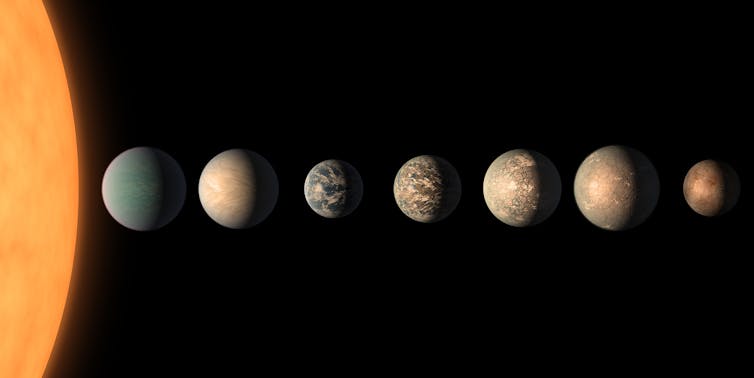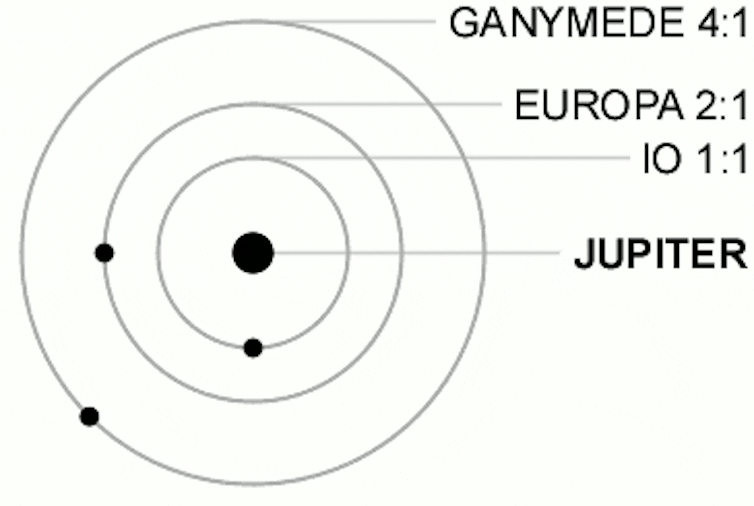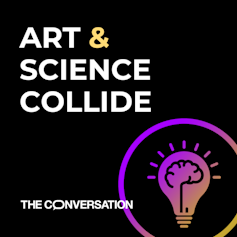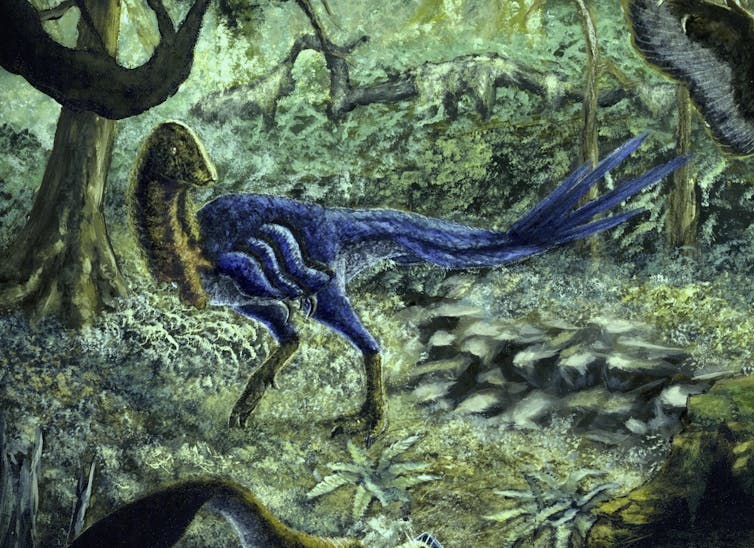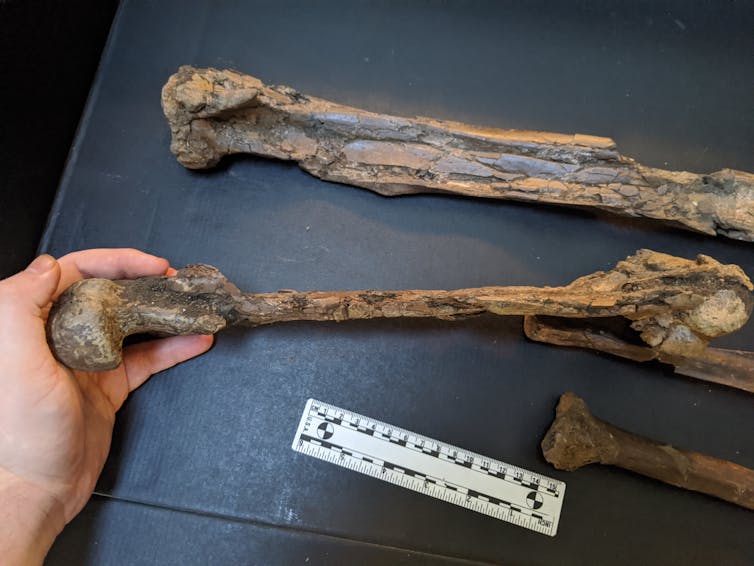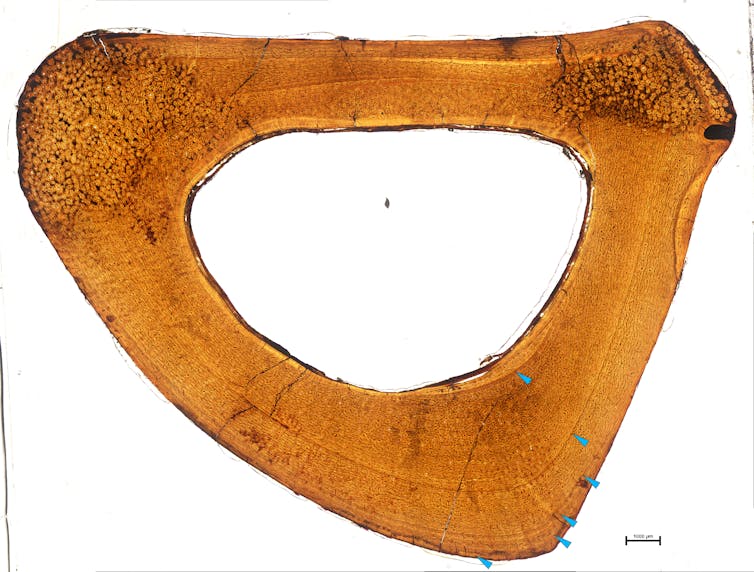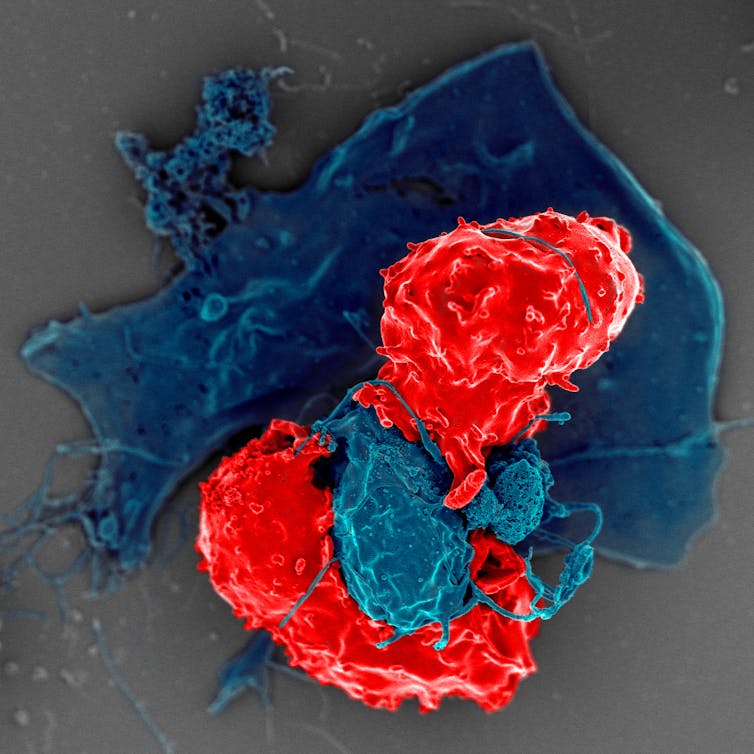Astronomers have long debated what kind of chemistry might serve as a bona fide alien biosignature. With the launch of the James Webb Space Telescope, those ideas may be put to the test.
In June, astronomers reported a disappointing discovery: The James Webb Space Telescope failed to find a thick atmosphere around the rocky planet TRAPPIST-1 C, an exoplanet in one of the most tantalizing planetary systems in the search for alien life.
The finding follows similar news regarding neighboring planet TRAPPIST-1 B, another planet in the TRAPPIST-1 system. Its dim, red star hosts seven rocky worlds, a few of which are in the habitable zone — at a distance from their star at which liquid water could exist on their surfaces and otherworldly life might thrive.
What it would take to detect that life, if it exists, isn’t a new question. But thanks to the JWST, it’s finally becoming a practical one. In the next few years, the telescope could glimpse the atmospheres of several promising planets orbiting distant stars. Hidden away in the chemistry of those atmospheres may be the first hints of life beyond our solar system. This presents a sticky problem: What qualifies as a true chemical signature of life?
“You’re trying to take very little information about a planet and make a conclusion that is potentially quite profound — changing our view of the whole universe,” says planetary scientist Joshua Krissansen-Totton of the University of Washington.
To detect such a biosignature, scientists must find clever ways to work with the limited information they can glean by observing exoplanets.
Chemicals in context
Even the most powerful telescopes, including the JWST, almost never “see” exoplanets — by and large, astronomers know these distant worlds only by the flickering of their stars.
Instead of viewing planets directly, astronomers train their telescopes on stars and wait for planets to “transit,” or pass between, their sun and the telescope. As a planet transits, a bit of starlight filters through its atmosphere and dims the star at certain wavelengths, depending on the chemicals in the atmosphere. The resulting dips and peaks in the star’s brightness are like a chemical barcode for the transiting planet.
Perhaps the most intuitive way to look for a biosignature in that barcode is to scour it for a gas that was clearly produced by life. For a time scientists thought that oxygen, which is abundant on Earth because of photosynthesis, served as a stand-alone biosignature. But oxygen can arise from other processes: Sunlight could break apart water in the planet’s atmosphere, for example.
And that problem isn’t unique to oxygen — most of the gases that living things produce can also arise without life. So instead of treating single gases as biosignatures in their own right, scientists today tend to consider them in context.
Methane, for instance, can be produced both with and without life. It wouldn’t be a convincing biosignature on its own. But finding methane and oxygen together “would be hugely exciting,” says planetary scientist Robin Wordsworth of Harvard University; it’s very difficult to produce that combination without life. Likewise, work by Krissansen-Totton and colleagues recently showed that finding methane along with the right amounts of other gases, such as carbon dioxide, would be hard to explain without life.
Watching how an exoplanet atmosphere changes over time might also provide valuable context that could strengthen otherwise weak biosignatures. Seasonal variations in the concentration of ozone, for example, could be a fingerprint of life, scientists reported in 2018.
Surprises, not assumptions
Of course, “if you’re looking for individual gases like oxygen or methane, then built into that are assumptions about what type of life is elsewhere,” says Krissansen-Totton. So some scientists are developing agnostic biosignatures that don’t assume alien biochemistry will be anything like Earth’s biochemistry.
One possible agnostic biosignature is an exoplanet atmosphere’s degree of chemical “surprisingness” — what scientists call chemical disequilibrium.
An atmosphere close to equilibrium would be chemically uninteresting, a bit like a closed flask of gas in a laboratory. Of course, no planet is as boring as a lab flask. Chemical reactions in a planet’s atmosphere can be powered by their stars and geological processes like volcanic activity can increase disequilibrium, and thus increase the chemical surprisingness of the atmosphere.
Life can also push planets away from equilibrium. And assuming that alien life produces gases of some kind, they could push a planet’s atmosphere much further from equilibrium than it would be otherwise. Yet disequilibrium alone “is not an unambiguous indicator,” says Krissansen-Totton.
In 2016, he and his colleagues calculated the thermal disequilibrium of the atmosphere of every planet in the solar system and Saturn’s moon Titan. By this measure, the Earth’s atmosphere stood out as extreme — but only if the oceans were built into the calculations. Ignoring its interactions with the ocean, the Earth’s atmosphere is actually closer to equilibrium than the atmosphere of Mars.
Still, even if it might not point to biology, finding an exoplanet atmosphere far from equilibrium would tell astronomers that something interesting is happening, Krissansen-Totton says, something that’s “modifying the atmosphere in a dramatic way that we need to understand.”
David Kinney, a philosopher of science at Yale University, recently worked with biophysicist Chris Kempes of the Santa Fe Institute to develop a new way of detecting possible agnostic biosignatures. It’s a deceptively simple idea: To find life, look for the weirdest planets.
If no assumptions are made about what alien life is like, practically any gas could be a biosignature in the right context. In 2016, MIT astrophysicist Sara Seager and colleagues proposed a list of about 14,000 molecules for consideration as possible biosignatures. Kinney and Kempes developed their assessment method by using that list of compounds, along with methods inspired by machine learning algorithms designed to recognize the odd-image-out in a set. This led to a way to precisely define and score the “weirdness” of a hypothetical exoplanet’s atmosphere compared to a set of other hypothetical atmospheres.
Kinney and Kempes argue that the weirdest atmospheres in a set are the most likely to host life. This rests on a few basic assumptions: Life in the universe is rare, it leaves traces in planetary atmospheres, and it’s hard to mimic those traces without life. Of course, those assumptions might turn out to be false, Kinney says. But “if we want to make no assumptions at all,” he adds, “then I think it’s very hard to make any kind of scientific progress, let alone in the area with such severe uncertainty as this one.”
First, understand non-life
To reduce that uncertainty, scientists will need to be able to confidently rule out non-life explanations for any potential biosignature. That requires a thorough understanding of alien geology and atmospheric chemistry. So instead of focusing on whether a planet is habitable, some scientists argue that studying obviously lifeless planets will bolster the search for alien life.
“There are so many really basic things that I think we need to learn about the planets first before we can even begin to ask the question of habitability,” says Laura Kreidberg of the Max Planck Institute for Astronomy in Germany, coauthor with Wordsworth of an overview of rocky exoplanet astronomy in the 2022 Annual Review of Astronomy and Astrophysics.
One enormous question is whether the potentially rocky planets that JWST can observe will have atmospheres at all. The only stars whose habitable-zone planets are within the telescope’s reach are red dwarfs, like TRAPPIST-1. These stars have a nasty habit of spewing harsh radiation that many scientists think would inevitably strip away the atmospheres of any habitable planets, which might explain the scant or nonexistent atmospheres of TRAPPIST-1 B and TRAPPIST-1 C.
Red dwarf stars also happen to be the most common in the Milky Way — so if their rocky planets can’t hold on to atmospheres, it would substantially winnow down the number of potentially habitable worlds.
If we can observe enough rocky exoplanets, “we’re going to be in a much, much stronger place to understand what a biosignature means,” says Wordsworth. “One really powerful thing that exoplanets give us is statistics.”
The word “biosignature” may evoke a smoking gun. But, says Krissansen-Totton, “exoplanet life discovery is going to be a gradual accumulation of evidence.”
As that evidence continues to roll in, scientists can begin to test their hypotheses about rocky planets in a rigorous way, and perhaps reevaluate them.
“Astronomy is, at its heart, such a discovery science,” says Kreidberg. “For all of our best-laid plans and frameworks and systems, as soon as we start getting data and observing things, everything turns upside down.”


